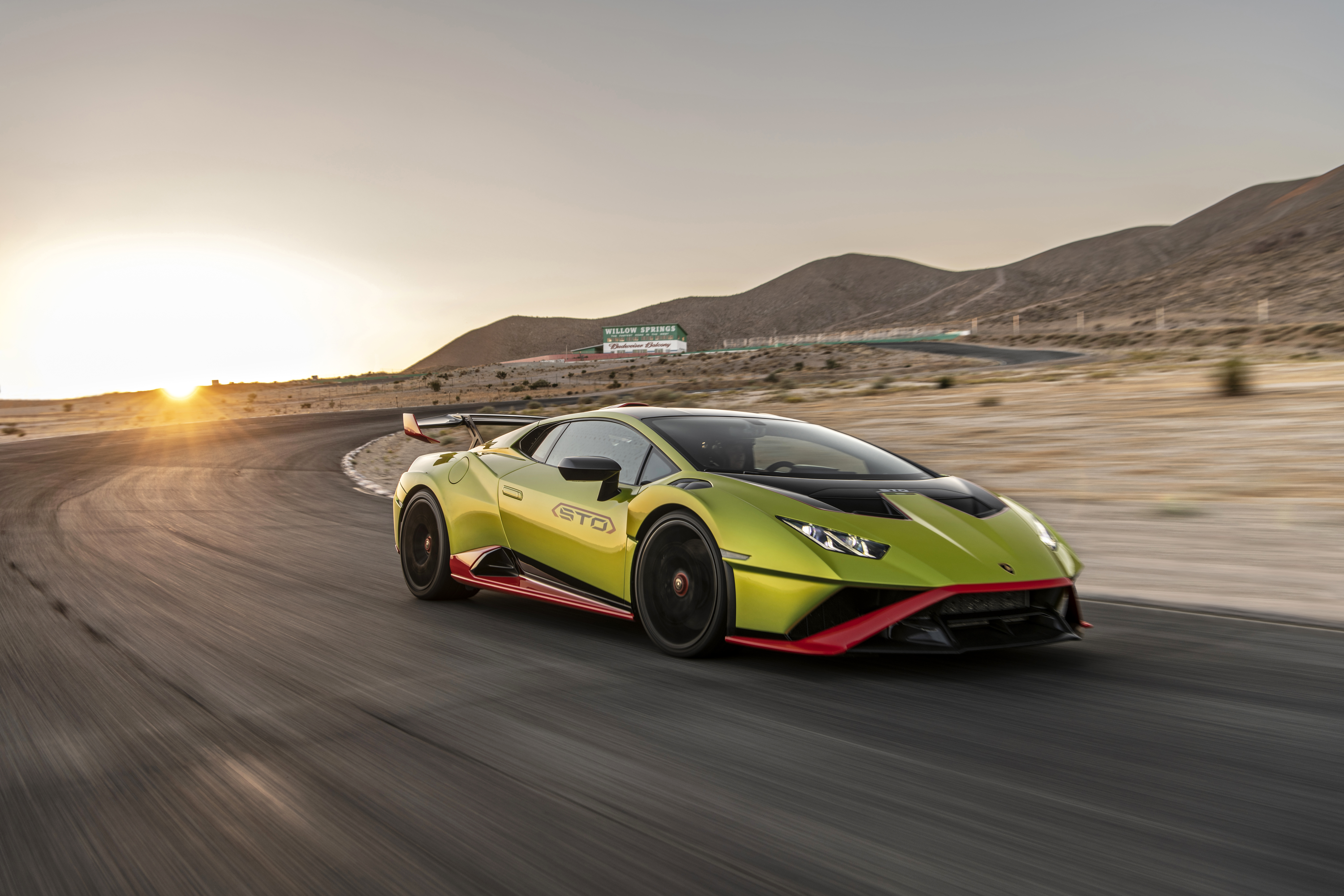
ROSAMUND, Calif. — It’s easy to think of Lamborghini as the flashy supercar for people who are more concerned with showing off than going fast.
And this is probably true if we’re honest. Head to any Cars & Coffee event, and you’ll see plenty of Lambos but far fewer Ferraris. There are many track-focused, but road-legal Ferrari and McLaren cars adorned with names like Speciale and Longtail.
It’s not that Lamborghini cars are slow. Far from it, the Lamborghini Huracan Performante set a (since-broken) production car lap record at the Nurburgring with a time of 6:52:01. But none of the more than 17,500 Huracans sold have ever been so specifically designed for racing as the new Huracan STO that I was able to drive last week at Willow Springs Raceway.
STO stands for Super Trofeo Omologata, and it’s a road-legal rocket ship taking inspiration from both the Huracan ST Evo and Huracan GT3 race cars — the latter of which won the 24 Hours of Daytona three years in a row.
Lamborghini Chief Technical Officer Maurizio Reggiani says the STO improves on the Performante in braking, lap time, consistency of performance, aerodynamics, and overall chassis control, which is impressive considering how able the Performante is.
Gone are the active aerodynamic pieces in favor of an enormous rear wing that can be quickly adjusted to three different positions with a screwdriver. It generates an astonishing 926 pounds of downforce at its maximum setting, double that of the Performante.
That helps put the power down at the car’s rear while simultaneously providing 37 percent better aerodynamic efficiency over the Performante. That means there’s more downforce but comparably less drag, which is the magic formula for Going Faster.
An air scoop above the engine gobbles up cool air from the top of the car and runs it over the top of the 640-horsepower naturally aspirated V10 to help maximize cooling when out on the track.
Making 75 percent of the body out of carbon fiber, ripping out the carpets and replacing the door handle with a floppy red piece of cloth helped reduce overall vehicle weight by nearly 95 pounds.
The body panels at the front of the car have been combined into one enormous carbon fiber piece. The two front fenders, hood, and front bumper are joined together into one vast bit of carbon fiber. This means far fewer brackets and mounting points are needed, and there are no
panel gaps to mess up that precious airflow. It also means that cargo space (already at a premium in the regular Huracan) is reduced to one cubic foot, or roughly enough room for a crash helmet and very little else.
There’s also a considerable amount of clever technology meant to get you set up for the track when you pull off the street. Because most people don’t have an entire race team helping them set up, the goal was to get the whole car ready for maximum attack with the flip of a switch.
On the steering wheel are three settings: STO, Trofeo, and Pioggia. They roughly translate to Street, Track, and Wet. In STO, the transmission stays in automatic mode, the traction and stability control modes are all active and protecting you, and the car is a dream to drive. It’s almost docile.
But with a single touch to Trofeo, the car gets red and angry, ready to charge. Track-oriented pedal maps (for more direct and predictable throttle response) are activated, the Magneride suspension firms up, and the transmission locks into full manual mode. And then it gets really clever.
Lamborghini’s engineers fitted the car with rear-wheel steering, but then it was tuned to approximate real-time adjustment of toe and camber angle setups (how the tire touches the ground, basically) to optimize performance on the track versus street. This is something that a bunch of expensive race engineers would do to an actual race car, but the STO allows drivers to do it with a toggle of the drive mode.
This is also true for the Torque Vectoring system. Using subtle braking on the rear wheels during turns, the system can simulate changes to the differential to maximize traction. Again, it allows the driver to get a race car feel out of a street car with a single button press.
The effect is intoxicating. After taking a lap in STO mode, I toggled to Trofeo, and it was like driving a different car. It wasn’t slow before, but it was a whole different beast once I set it up for the track. Turn in was sharper and more precise, the throttle was predictable, and the downforce was mind-boggling.
I was able to launch into and out of corners at speeds my brain could scarcely believe, and the faster I went, the happier it was. And when I ran out of bravery, the Formula One-derived carbon-ceramic brakes were happy to slow things down.
New on the STO is a traffic-light green/yellow/red system that watches brake temps for each wheel, advising on the center screen whether you’ve gotten a bit too enthusiastic and need to take a few cooling laps. Reggiani said he could never make the system go red through all the development and testing of the car, which is a testament to all the cooling tricks Lamborghini’s engineers have stuffed into this car.
But perhaps the coolest part of the STO is a new connected telemetry feature. The car has onboard cameras looking at both the steering wheel from behind the driver and at the road ahead, and the STO can record both live telemetry and video from racing laps. This part isn’t particularly unique. But because the car has an onboard data connection, it’ll upload your recordings in real-time to the cloud, where you can look at and analyze them on your phone.
And, best of all, you can share those videos with your friends or post ’em on social media. Ah, now we’re back on firmer Lamborghini ground with what the Huracan does best: showing off.
We’ll have to wait and see what the new Huracan STO does at the Nurburgring, but don’t be surprised if Lamborghini throws down another production car record.




